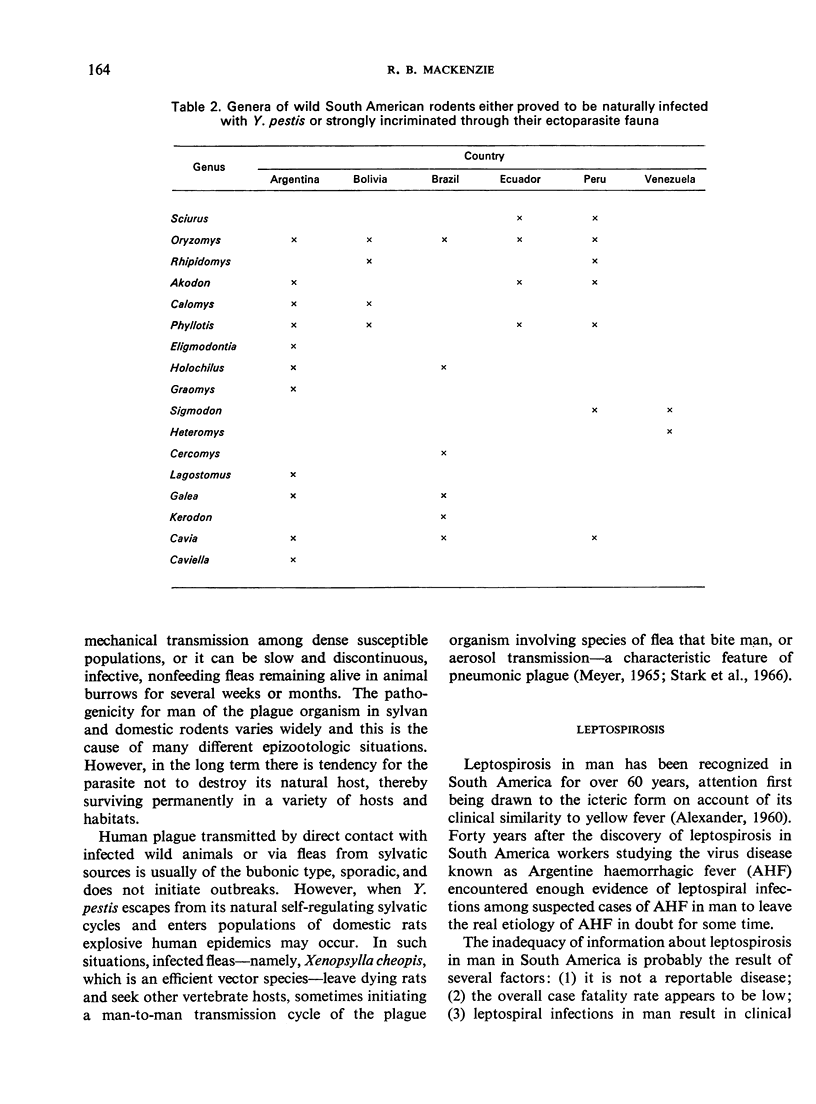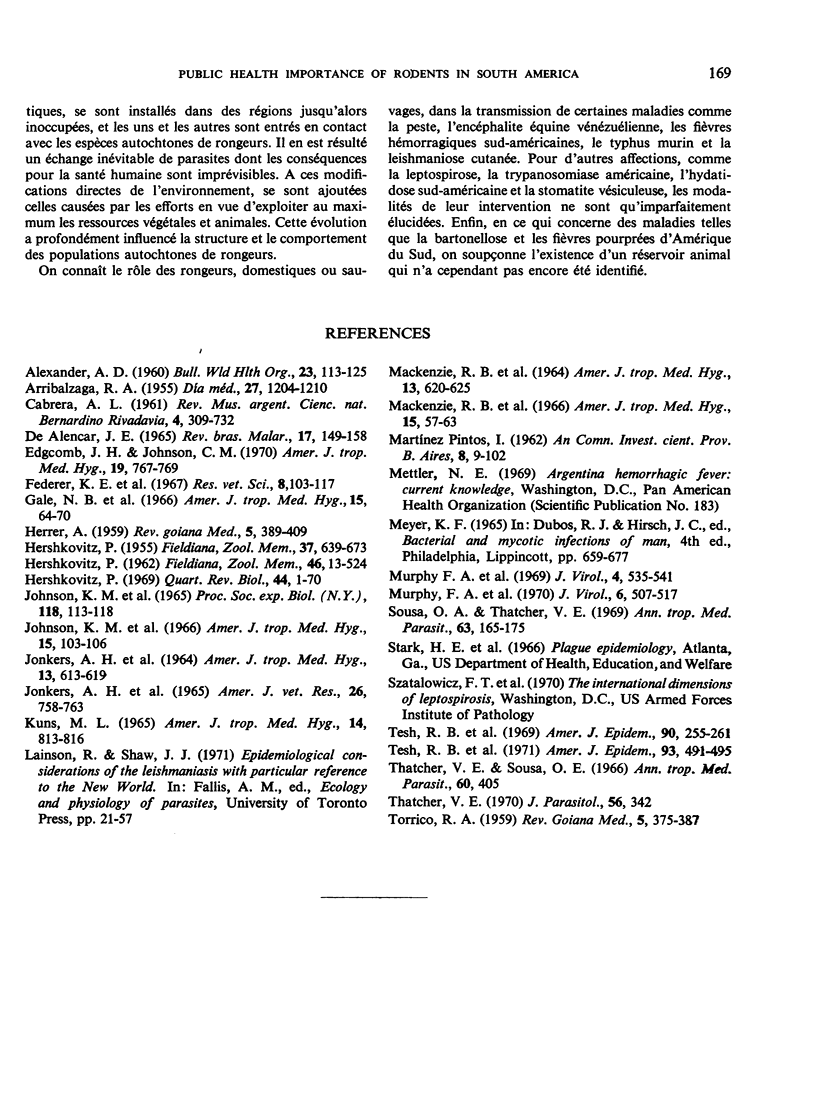Abstract
Indigenous South American rodents are abundant, varied, and adaptable, and occupy most of the available natural habitats. Knowledge of their taxonomy and biology is generally superficial. Near human habitations the introduced Rattus and Mus are common and their contacts with man are often close. Cities in South America are expanding to keep pace with increases in the human population and hitherto virgin land is being settled or cleared for food production. Thus domestic rodents are brought into contact with indigenous species and the inevitable exchange of parasites may then produce unpredictable threats to human health. The role of both wild and domestic rodents in the transmission of certain infectious diseases, such as plague, sylvatic Venezuelan encephalitis, South American haemorrhagic fevers, murine typhus, and cutaneous leishmaniasis, is well established. The involvement of rodents in some other diseases, such as leptospirosis, American trypanosomiasis, South American hydatid disease, and vesicular stomatitis, is less well understood. In certain other infections, including bartonellosis and the South American spotted fevers, a wild rodent reservoir is inferred but not yet identified.
Full text
PDF








Selected References
These references are in PubMed. This may not be the complete list of references from this article.
- ALEXANDER A. D. The distribution of leptospirosis in Latin America. Bull World Health Organ. 1960;23:113–125. [PMC free article] [PubMed] [Google Scholar]
- ARRIBALZAGA R. A. Una nueva enfermedad epidémica a germen desconocido: hipertermia nefrotóxica, leucopénica y enantemática. Dia Med. 1955 Jun 16;27(40):1204–1210. [PubMed] [Google Scholar]
- Edgcomb J. H., Johnson C. M. Natural infection of Rattus rattus by Trypanosoma cruzi in Panamá. Am J Trop Med Hyg. 1970 Sep;19(5):767–769. doi: 10.4269/ajtmh.1970.19.767. [DOI] [PubMed] [Google Scholar]
- Federer K. E., Burrows R., Brooksby J. B. Vesicular stomatitis virus--the relationship between some strains of the Indiana serotype. Res Vet Sci. 1967 Jan;8(1):103–117. [PubMed] [Google Scholar]
- Gale N. B., Alexander A. D., Evans L. B., Yager R. H., Matheney R. G. An outbreak of leptospirosis among U. S. army troops in the Canal Zone. Am J Trop Med Hyg. 1966 Jan;15(1):64–70. doi: 10.4269/ajtmh.1966.15.64. [DOI] [PubMed] [Google Scholar]
- JOHNSON K. M., WIEBENGA N. H., MACKENZIE R. B., KUNS M. L., TAURASO N. M., SHELOKOV A., WEBB P. A., JUSTINES G., BEYE H. K. VIRUS ISOLATIONS FROM HUMAN CASES OF HEMORRHAGIC FEVER IN BOLIVIA. Proc Soc Exp Biol Med. 1965 Jan;118:113–118. doi: 10.3181/00379727-118-29772. [DOI] [PubMed] [Google Scholar]
- JONKERS A. H., SPENCE L., AITKEN T. H. COCAL VIRUS EPIZOOTIOLOGY IN BUSH BUSH FOREST AND THE NARIVA SWAMP, TRINIDAD, W.I.: FURTHER STUDIES. Am J Vet Res. 1965 May;26:758–763. [PubMed] [Google Scholar]
- JONKERS A. H., SPENCE L., COAKWELL C. A., 3rd, THORNTON J. J., 3rd LABORATORY STUDIES WITH WILD RODENTS AND VIRUSES NATIVE TO TRINIDAD. I. STUDIES ON THE BEHAVIOR OF COCAL VIRUS. Am J Trop Med Hyg. 1964 Jul;13:613–619. doi: 10.4269/ajtmh.1964.13.613. [DOI] [PubMed] [Google Scholar]
- Johnson K. M., Kuns M. L., Mackenzie R. B., Webb P. A., Yunker C. E. Isolation of Machupo virus from wild rodent Calomys callosus. Am J Trop Med Hyg. 1966 Jan;15(1):103–106. doi: 10.4269/ajtmh.1966.15.103. [DOI] [PubMed] [Google Scholar]
- Kuns M. L. Epidemiology of Machupo virus infection. II. Ecological and control studies of hemorrhagic fever. Am J Trop Med Hyg. 1965 Sep;14(5):813–816. doi: 10.4269/ajtmh.1965.14.813. [DOI] [PubMed] [Google Scholar]
- MACKENZIE R. B., BEYE H. K., VALVERDE L., GARRON H. EPIDEMIC HEMORRHAGIC FEVER IN BOLIVIA. I. A PRELIMINARY REPORT OF THE EPIDEMIOLOGIC AND CLINICAL FINDINGS IN A NEW EPIDEMIC AREA IN SOUTH AMERICA. Am J Trop Med Hyg. 1964 Jul;13:620–625. [PubMed] [Google Scholar]
- Mackenzie R. B., Reiley C. G., Alexander A. D., Bruckner E. A., Diercks F. H., Beye H. K. An outbreak of leptospirosis among U. S. army troops in the Canal Zone. Am J Trop Med Hyg. 1966 Jan;15(1):57–63. doi: 10.4269/ajtmh.1966.15.57. [DOI] [PubMed] [Google Scholar]
- Murphy F. A., Webb P. A., Johnson K. M., Whitfield S. G., Chappell W. A. Arenoviruses in Vero cells: ultrastructural studies. J Virol. 1970 Oct;6(4):507–518. doi: 10.1128/jvi.6.4.507-518.1970. [DOI] [PMC free article] [PubMed] [Google Scholar]
- Murphy F. A., Webb P. A., Johnson K. M., Whitfield S. G. Morphological comparison of Machupo with lymphocytic choriomeningitis virus: basis for a new taxonomic group. J Virol. 1969 Oct;4(4):535–541. doi: 10.1128/jvi.4.4.535-541.1969. [DOI] [PMC free article] [PubMed] [Google Scholar]
- Sousa O. E., Thatcher V. E. Observations on the life-cycle of Echinococcus oligarthrus (Diesing, 1863) in the Republic of Panama. Ann Trop Med Parasitol. 1969 Jun;63(2):165–175. doi: 10.1080/00034983.1969.11686614. [DOI] [PubMed] [Google Scholar]
- Tesh R. B., Peralta P. H., Johnson K. M. Ecologic studies of vesicular stomatitis virus. I. Prevalence of infection among animals and humans living in an area of endemic VSV activity. Am J Epidemiol. 1969 Sep;90(3):255–261. doi: 10.1093/oxfordjournals.aje.a121068. [DOI] [PubMed] [Google Scholar]
- de Alencar J. E. Estudos sôbre a epidemiologia da doença de Chagas no ceará. 3. Região do Baixo Jaguaribe. Rev Bras Malariol Doencas Trop. 1965 Apr-Sep;17(2):149–158. [PubMed] [Google Scholar]


